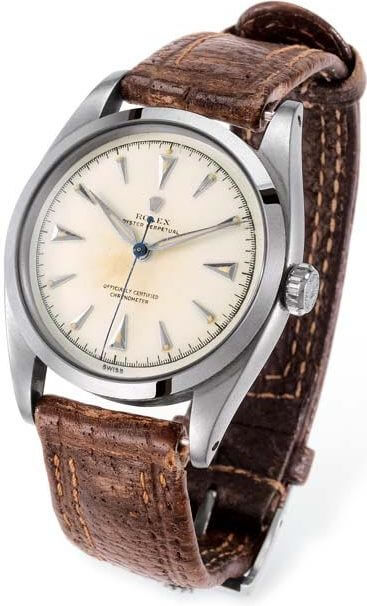No plane takes off without a watch in the cockpit. Essential navigational instruments until electronics took their place, dials were prominent on aircraft control panels. When Charles Lindbergh flew from New York to Paris in 1927, he watched the hours go by on an eight-day Waltham. The American became the first person to fly non-stop across the Atlantic, an epic voyage lasting 33 hours and 30 minutes. This was one of the first exploits with which watches were directly associated.
Building on his experience, the hero went on to work with Longines to develop a watch especially for pilots, the Longines Hour Angle. Used alongside a sextant, a nautical almanac and a radio receiver for the hour signal, it enabled pilots to rapidly calculate the Greenwich hour angle, i.e. longitude.
Rolex masters the heights
After horizontal records came vertical exploits! On May 29th 1953, New-Zealander Edmund Hillary and sherpa Tensing Norgay hauled themselves to the top of Everest. Fourteen expeditions had gone before them and all had failed. The one thing these mountaineers had in common: each wore a Rolex Oyster Perpetual.
Twenty years earlier, in 1933, Stewart Blacker had flown over the roof of the world to charter the area. On his return, he wrote to the director of Rolex to inform him that the watches which had accompanied the expedition had given full satisfaction: “I doubt that any other watch has endured such extreme conditions, going from 84°C to -41°C in a matter of minutes,” he exclaimed.
Having dominated the highest peaks, the next challenge lay beneath the oceans, and once again Rolex pushed back the limits. In 1960, Switzerland’s Jacques Piccard embarked on a mission to explore the Mariana Trench in his bathyscaphe. Attached to the outside was a curious watch with a dome-shaped crystal, the Oyster Deep Sea Special. Thanks to this special structure, it was able to withstand pressure in excess of one tonne per sq. cm., the weight of the water at 10,916 metres, the depth the explorer reached.
Into the void
Having explored the Earth from every angle, the next missions would take man into space. On April 12th 1961, the Russian cosmonaut Yuri Alekseyevich Gagarin orbited the Earth in his Vostok 3KA-2 space capsule. He wore a “Shturmanskie” (a transliteration of “navigator”), a pure Russian product made at the First Moscow Watch Factory Kirov (all the factories were numbered).
Stateside, the Americans left their early space explorers more freedom of choice. They could decide whether or not to supplement in-cabin instruments with a watch. On February 22nd 1962, John Glenn lifted off from Cape Canaveral aboard Friendship 7 as part of the Mercury-Atlas 6 mission. He took with him the first Swiss watch to leave the Earth for a significant length of time, a Heuer sports counter reference 2915A that was accurate to one-fifth of a second. On May 24th that same year, a Breitling Navitimer Cosmonaut orbited the Earth on Scott Carpenter’s wrist for Mercury-Atlas 7. The Omega Speedmaster stepped into the spotlight with Walter Schirra, who on October 3rd piloted Sigma 7. The Omega provided back-up for the in-cabin instruments for this, its first space flight.
American watchmakers had a hard time accepting the omnipresent Swiss brands. This is why, for the last Mercury mission in 1963, Gordon Cooper took with him a mechanical Omega Speedmaster and an electronic Bulova Accutron Astronaut, to compare the accuracy of the two. Swiss technology won the day.
Consecration for the Speedmaster
Soon watches would no longer be chosen at random. In 1961, the United States President John F. Kennedy challenged the nation to land a man on the moon before the decade was out. The North American Space Agency (NASA) was given the resources to fulfil this ambition. An instrument with which to measure time was among the equipment such a mission would need. Twelve models by different brands were purchased incognito from a Houston store and submitted to ruthless tests, including water-resistance and resistance to shock, vibrations and extreme temperature variations. One of the watches on trial was the Omega Speedmaster. In 1965, the agency announced that the Omega chronograph had outperformed all the others and would be standard issue to each crew member. After successfully completing a second selection process, the Speedmaster was chosen for the first lunar mission. It would count the two hours and forty minutes the astronauts were to spend on the surface of the moon.
An incident during a mission would set the final stone in the Speedmaster legend. On April 14th 1970, the NASA control centre received a distress message from the Apollo XIII mission. One of the module’s two oxygen tanks had exploded. The three astronauts had a tiny amount of water and just enough power to operate the radio receiver. Commander James Lovell used his Omega Speedmaster to precisely time the firing and functioning of the secondary engine and bring the crew safely back to Earth.

















